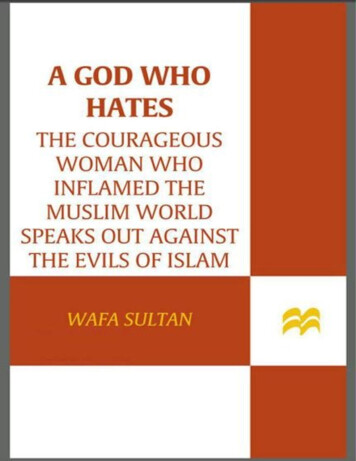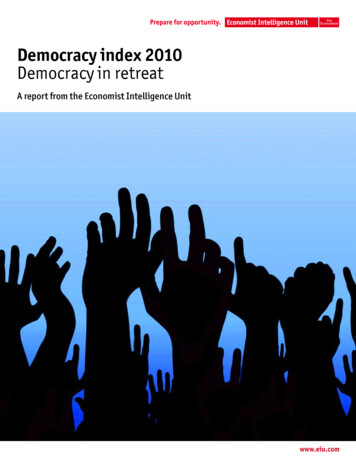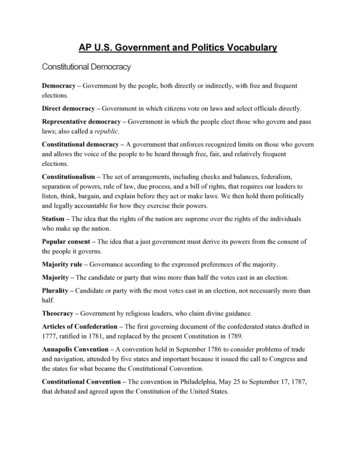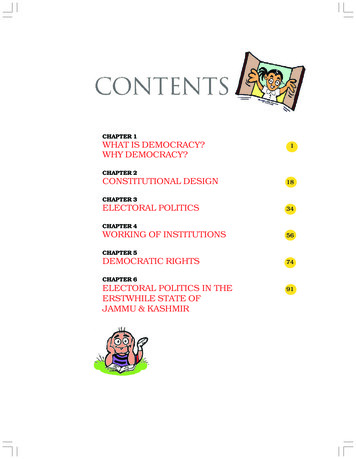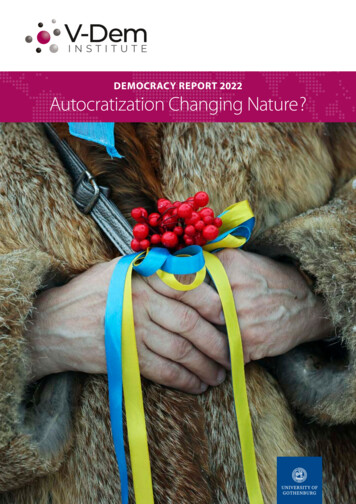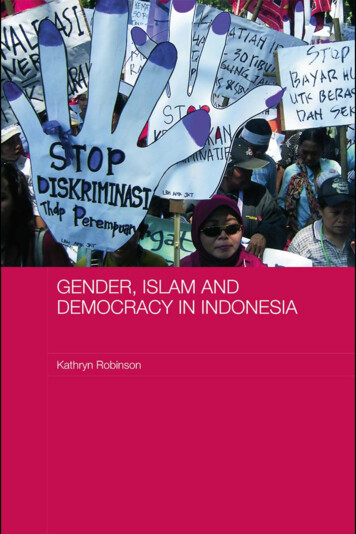
Transcription
Gender, Islam and Democracy inIndonesiaThis book explores the relationship between gender, religion and political actionin Indonesia, examining the patterns of gender orders that have prevailedin recent history, and demonstrating the different forms of social power this hasafforded women. It sets out the part played by women in the nationalist movement, and the role of the women’s movement in the structuring of the independent Indonesian state, the politics of the immediate post-independence periodand the transition to the authoritarian New Order. It analyses in detail the genderrelations of the New Order regime, focused around the unitary family formexpounded in New Order ideology and the contradictory implications of theopening up of the economy to foreign capital and ideas for gender relations. Itexamines the forms of political activism that were possible for the women’smovement under the New Order, and the role it played in the fall of Suhartoand the transition to democracy. The relationship between Islam and women inIndonesia is also addressed, highlighting the way in which Islam became acritical focus for political dissent in the late New Order period. Overall, thisbook provides a thorough investigation of the relationship between gender, religion and democracy in Indonesia, and is a vital resource for students of genderstudies and Indonesian affairs.Kathryn Robinson is Professor in the Department of Anthropology, ResearchSchool of Pacific and Asian Studies at The Australian National University.She is editor of The Asia Pacific Journal of Anthropology. Her research interestsfocus on women’s social participation in Indonesia, including women’s politicalactivism, Islam and international female labour migration.
Asian Studies Association of AustraliaWomen in Asia SeriesEditor: Louise Edwards (University of Technology, Sydney)Editorial Board:Susan Blackburn (Monash University)Vera Mackie (Melbourne University)Anne McLaren (Melbourne University)Mina Roces (University of New South Wales)Andrea Whittaker (Melbourne University)Mukkuvar WomenGender, hegemony and capitalisttransformation in a South Indianfishing communityKalpana RamA World of DifferenceIslam and gender hierarchy inTurkeyJulie MarcusPurity and Communal BoundariesWomen and social change in aBangladeshi villageSanti RozarioMadonnas and MartyrsMilitarism and violence in thePhilippinesAnne-Marie HilsdonMasters and ManagersA study of gender relations in urbanJavaNorma SullivanMatriliny and ModernitySexual politics and social change inrural MalaysiaMaila StivensIntimate KnowledgeWomen and their health inNorth-east ThailandAndrea WhittakerWomen in AsiaTradition, modernity andglobalisationEdited by Louise Edwards and MinaRocesViolence against Women in AsianSocietiesGender inequality and technologiesof violenceEdited by Lenore Manderson andLinda Rae BennettWomen’s Employment in JapanThe experience of part-time workersKaye BroadbentChinese Women—Living andWorkingAnne McLarenAbortion, Sin and the State inThailandAndrea Whittaker
Asian Studies Association of Australia iiiSexual Violence and the Law in JapanCatherine BurnsWomen’s Movement in PostcolonialIndonesiaGender and nation in a newdemocracyElizabeth MartynGender Diversity in IndonesiaBeyond gender binariesSharyn Leanne GrahamYoung Women in JapanTransitions to adulthoodKaori OkanoWomen, Islam and ModernitySingle women, sexuality andreproductive health in contemporaryIndonesiaLinda Rae BennettSex, Love and Feminism in theAsia PacificA cross-cultural study of youngpeople’s attitudesChilla BulbeckWomen and Labour Organizing inAsiaDiversity, autonomy and activismEdited by Kaye Broadbent andMichele FordGender, State and Social PowerDivorce in contemporary IndonesiaKate O’ShaughnessyWomen and Work in IndonesiaMichele Ford and Lyn ParkerWomen, Islam and Everyday LifeRenegotiating polygamy in IndonesiaNina NurmilaGender, Islam and Democracy inIndonesiaKathryn RobinsonFeminist Movements inContemporary JapanLaura Dales
Gender, Islam and Democracyin IndonesiaKathryn Robinson
First published 2009 by Routledge2 Park Square, Milton Park, Abingdon, Oxon OX14 4RNSimultaneously published in the USA and Canadaby Routledge270 Madison Ave, New York, NY 10016This edition published in the Taylor & Francis e-Library, 2008.“To purchase your own copy of this or any of Taylor & Francis or Routledge’scollection of thousands of eBooks please go to www.eBookstore.tandf.co.uk.”Routledge is an imprint of the Taylor & Francis Group, an informabusiness 2009 Kathryn RobinsonAll rights reserved. No part of this book may be reprinted or reproducedor utilised in any form or by any electronic, mechanical, or other means,now known or hereafter invented, including photocopying and recording,or in any information storage or retrieval system, without permission inwriting from the publishers.British Library Cataloguing in Publication DataA catalogue record for this book is available from the British LibraryLibrary of Congress Cataloging in Publication DataRobinson, Kathryn May, 1949–Gender, Islam, and Democracy in Indonesia / Kathryn Robinson.p. cm. — (ASAA women in Asia series)Includes bibliographical references and index.1. Women—Indonesia. 2. Women—Government policy—Indonesia.3. Women in politics—Indonesia. 4. Women in Islam—Indonesia.I. Title.HQ1752.R63 2008305.48’89922—dc222008009224ISBN 0-203-89175-9 Master e-book ISBNISBN10: 0-415-41583-7 (hbk)ISBN10: 0-203-89175-9 (ebk)ISBN13: 978-0-415-41583-7 (hbk)ISBN13: 978-0-203-89175-9 (ebk)
ContentsSeries Editor’s ForewordAcknowledgementsIntroduction—Gender, Islam and Democracy in Indonesiaviiiix11 Gender Diversity in Indonesia102 People’s Sovereignty, Gender Equity333 The Gender Order of the New Order684 The Gendered Economy895 Globalization of Culture-Sex and Sexuality1196 Political Challenges to the State Gender Regime1367 Islam and the Politics of 194200205225
Series Editor’s ForewordThe contributions of women to the social, political and economic transformations occurring in the Asian region are legion. Women have served as leaders ofnations, communities, workplaces, activist groups and families. Asian womenhave joined with others to participate in fomenting change at micro and macrolevels. They have been both agents and targets of national and internationalinterventions in social policy. In the performance of these myriad roles womenhave forged new and modern gendered identities that are recognizably globaland local. Their experiences are rich, diverse and instructive. The books inthis series testify to the central role women play in creating the new Asia andre-creating Asian womanhood. Moreover, these books reveal the resilience andinventiveness of women around the Asian region in the face of entrenchedand evolving patriarchal social norms.Scholars publishing in this series demonstrate a commitment to promoting theproductive conversation between Women’s Studies and Asian Studies. The needto understand the diversity of experiences of femininity and womanhood aroundthe world increases inexorably as globalization proceeds apace. Lessons fromthe experiences of Asian women present us with fresh opportunities for buildingnew possibilities for women’s progress the world over.The Asian Studies Association of Australia (ASAA) sponsors this publicationseries as part of its ongoing commitment to promoting knowledge about womenin Asia. In particular, the ASAA women’s caucus provides the intellectual vigourand enthusiasm that maintains the Women in Asia Series (WIAS). The aim ofthe series, since its inception in 1990, is to promote knowledge about women inAsia to both the academic and general audiences. To this end, WIAS books drawon a wide range of disciplines including anthropology, sociology, politicalscience, cultural studies and history. The series could not function without thegenerous professional advice provided by many anonymous readers. Moreover,the wise counsel provided by Peter Sowden at Routledge is invaluable. WIAS,its authors and the ASAA are very grateful to these people for their expertwork.Louise Edwards (University of Technology, Sydney)Series Editor
AcknowledgementsThe research for this book spans 30 years of research in Indonesia. I have learnedfrom many people, in ‘the field’ in Indonesia and also from colleagues andfriends in Australia, Indonesia, the USA and Europe. In Indonesia, KhofifahIndar Parawansa, Nursyahbani Katjasungkana, Saparinah Sadli, Mely Tan,Mayling Oey-Gardiner, Lies Marcoes, Lily Munir, Yulfita Raharjo, MelaniBudianta, Ciciek Farha, Zohra Andi Baso and Ani Seotjipto have been inspirational in regard to the subject matter of this book, and provided friendship andsupport. I have had the privilege of supervising many Indonesian postgraduatestudents, many of whom have deepened my understanding of the mattersdiscussed in this book. In particular, I mention Nurul Ilmi Idrus, Indraswari,Nicolaas Warouw, Safira Machrusah, Nadirsyah Hosen, Yulia Immajati, Kurniawati Hastuti Dewi, Deny Hamdani, Wahidah Zein Br Siregar, Murni Mahnud,Yasir Alimi, Eva Amrullah and Faried F. Saenong.The Women’s Forum of the Asian Studies Association of Australia providesa stimulating and supportive environment for feminist scholarship on Asia,and I particularly wish to thank Susan Blackburn, Helen Creese, BarbaraHatley, Barbara Leigh, Lyn Parker and Krishna Sen. Louise Edwards, theWIA Series Editor, is a bright star in this arena and has given invaluableencouragement for the completion of this book.I am privileged to work with the world’s best concentration of Indonesiascholars at ANU, and I owe special thanks to Sharon Bessell, James J. Fox,Virginia Hooker, Kuntala Lahiri-Dutt, Andrew McWilliam and Chris Manning.Ann Curthoys, Dorothy Broom, Margaret Jolly and Marian Sawer, all ANUscholars whose research is in the area of gender and sexuality, have been keycolleagues. I completed some of this manuscript in periods of leave at theHumanities Research Centre at ANU, and I thank Caroline Turner in particularfor her support.Many of the arguments in this book have been developed in conference andseminar papers as well as publications. In this process, I have benefited fromcritical dialogue from a large number of scholars, and in addition to those namedabove, I would like to thank Kathleen Adams, Lorraine Aragon, Tom Boellstorff,Tony Day, Don Nonini and Pnina Werbner.
x AcknowledgementsRaewyn Connell read an earlier version of the manuscript and provided theincisive and encouraging critical commentary I had experienced of her whenI was an undergraduate. Jennifer Alexander, Katherine Gibson, Ciciek Farha,Susanna Price and Deidre McKay read early drafts. Fritha Jones and EmmyQuinn have provided invaluable research assistance, and Belinda Henwood ofRent-a-Writer has assisted me in preparing the manuscript for publication.
Introduction—Gender, Islam andDemocracy in IndonesiaIn February 1998, the ‘dying days’ of the authoritarian regime of PresidentSuharto, a group of women occupied the roundabout outside the Hotel Indonesia(HI), a hectic road junction on one of Jakarta’s busiest streets. The motoristswhose passage was impeded were handed roses, packets of milk powder andpamphlets protesting the rising costs of basic commodities consequent on theAsian financial crisis. The protesters singled out the problems faced by womenin meeting the basic needs of their families. The group organizing the protestcalled itself Suara Ibu Peduli (SIP), or the Voice of Concerned Mothers. Their‘demo susu’ (milk demonstration) drew on the central trope of womanhood inthe state ideology of Suharto’s self-styled New Order regime (1966–98): thewife and mother, whose principal duty as a citizen was to raise a new generationof Indonesians. The demo susu attracted extensive publicity, both nationally andinternationally, due to its brilliant theatricality and the televised images of thebrave but clearly terrified women being dragged off by the police. Their chosenlocation, outside Jakarta’s first modern skyscraper hotel built soon after independence, is redolent with symbolism of the pride and optimism in the nationalist spirit of the post-independence Sukarno presidency (1945–65): it invokes apolitical memory that is in stark contrast to the ethos of the authoritarianSuharto government. Two of the women arrested, Karlina Leksono and GadisArivia, were among the organizers of the demonstration, but the third, Wilasih,was a passer-by who had spontaneously joined the protest. Her action symbolized the extraordinary and immediate appeal the protest had for a wide rangeof Indonesian women and its powerful engagement with the symbolism ofwomen as mothers that was part of New Order hegemonic ideology.In the demonstrators’ trial, the feminist human rights lawyer NursyahbaniKatjasungkana addressed the failure of the state to protect their human rights.The women used the trial to protest not just the economic crisis but also the‘crisis in trust’ in the government, symbolized in the denial of their right to freespeech. The trial gained even more publicity for SIP and triggered a spontaneousgrowth of the organization, including sectors of the population (especiallythe lower middle class) which had not hitherto been associated with women’sactivism. Women established local chapters of SIP, setting up warung sembako(food kiosks selling the basic commodities at low prices) to help householdssurvive the economic crisis.
2 Introduction—Gender, Islam and Democracy in IndonesiaThe visibility of women on the street in the period of Indonesia’s transitionto democracy contrasts with their absence from mainstream political analyses.The ‘hegemonic’ analyses of Indonesian politics, in which a particular kind ofliberal discourse is dominant (Philpott 2000), have been called ‘gender blind’(Blackburn 1991; Stivens 1991; Taylor 1997a): this criticism reflects the humanistposition which presumes the impossibility of addressing politics, and especiallydemocratization, while not taking account of the agency and interests of over halfof the population. However, the absence of gendered analysis in the mainstreampolitical analyses of the New Order also has more serious implications. Manywomen scholars have analysed the gender policies of the New Order (see, forexample, Robinson 1994; Sunindyo 1996; Suryakusuma 1996). However, thisbook is the first interpretation of Indonesian politics that is fully informed bymodern gender theory that analyses gender relations as an aspect of the exerciseof power in society. Women’s active political participation to shape the nation’sgender order is an important part of this story, which locates contemporaryIndonesian gender politics in a wider frame of gender activism on a global scale(Connell 2002). I am especially concerned to analyse the gender politics ofSuharto’s New Order and the period of Reformasi that succeeded it.The ‘gender relations’ perspective adopted in this book leads us to enquire intothe generalized social and political effects of the unitary ‘gender regime’ whichwas a construct of New Order ideology, not just the immediate consequencesfor ‘women as a group’. How significant were gendered structures of power instrategies for managing the population under the steadily gathering authoritariancharacter of the New Order? What are the implications of women’s challengesto the gender regimes of successive state formations for the reconfiguration ofpower relations, for example, in the context of regime change?Indonesia has a population of 217 million, of whom around 80 per centprofess Islam. The poetic invocation of the idea of nation is ‘land and sea’ (tanahair) and the population is scattered across more than 17,000 islands that spanthe equator, divided among over 700 language groups that were forged into amodern nation state over several hundred years of gradual expansion of Dutchcolonial rule, which ended in 1945. This book begins with an anthropologicalanalysis of the diverse gender orders in the archipelago. A ‘gender order’, usingJill Mathew’s (1984) term, is a historically constructed pattern of powerrelations between men and women and a definition of femininity and masculinity. The term has been used by Connell (1987; 2000; 2002) to refer to the‘structural inventory of a society’ in regard to gender relations. I utilizethe framework developed in the work of R. W. Connell in which the overallpatterning of gender relations within an institution, termed ‘the gender regime’,is analysed across a range of structures, analytically distinguished as powerrelations, production relations, emotional relations and gender symbolism. In theanalysis of a broad social field such as the Indonesian nation, there are manygender regimes, which can be collectively understood as the gender order, the‘overall patterning of gender regimes, together with the gender patterning of aculture and personal life. . . . It is implicit in these concepts that gender regimes
Introduction—Gender, Islam and Democracy in Indonesia 3and gender orders are historical products and subject to change in history’(Connell 2000: 29).The localized gender orders of the constituent cultures of the archipelagomanifest transformation through, inter alia, the progressive influence of worldreligions—particularly Islam which has been slowly penetrating the archipelagosince about the eleventh century—and the later impact of colonialism andglobal capitalism. This book analyses the relevance of the contemporaryIslamic revival to gender politics in the country with the world’s largest Muslimpopulation during the Reform period (termed Reformasi) that succeededSuharto’s New Order in 1998.***The demo susu was the first in a series of protests that culminated in theoccupation of the Indonesian parliament building in May 1998, following themurder of student protesters by the Indonesian military (Forrester 1999). SIPwas again at the forefront. Some members had acted as ambulance driversduring confrontations between protesters and state military/police ferrying casualties to hospital, mirroring one of the roles women played in the nationaliststruggle of the 1940s. They soon found themselves enacting a more maternalrole, though not one encompassed by the New Order ‘duty statements’ forwomen. A shipment of fast food of unknown provenance was delivered to theoccupying students, evincing fears that the government might be fighting theiropponents with contaminated food. SIP members took over the role of cateringfor the protesters, with food supplied from domestic kitchens from homes allover Jakarta.Sections of the regime responded to the populist challenge to their power byinstigating riots in Jakarta, targeting Chinese Indonesians who were scapegoatedfor the economic misery of the financial crisis. During the May 1998 riots,women of Chinese descent were systematically raped. The report of the rapesprecipitated public outrage and led to subsequent revelations of the ‘publicsecret’ of rape as an instrument of war that had been used against civilianpopulations in East Timor and Aceh. The public façade of the normative paternalism of the New Order was stripped away to reveal the violent militarizedmasculinity at its core.While many analyses of the events surrounding his fall have been published,little has been written about the active roles women have played in thedemocracy movement and the shift in gender politics after the fall of Suharto.International Women’s Day, Human Rights Day and the International Dayagainst Violence against Women have all been marked by mass demonstrationsby women across the country in the Reform era. Indonesia’s own national daysfor celebrating women as citizens (Kartini Day and Mother’s Day), used bythe New Order to celebrate official ideologies of womanhood, have also beenreinstated as symbols of women’s rights in a modern nation through streetdemonstrations.
4 Introduction—Gender, Islam and Democracy in IndonesiaIn May 2006, another signature demonstration happened on the streets ofJakarta: protesters displaying symbols of Islam marched in support of a draftbill ostensibly banning pornography and ‘pornoaksi’ (the term coined to meanperpetrators of a pornographic act)—which they saw as a legacy of the openingof Indonesia to the West under the New Order. The (predominantly male) crowdswere responding to a demonstration that had been organized by women’s groupsin April (on Kartini Day) in protest at the bill, which contains clauses that criminalize women’s body movements and display of body parts, restrict women’sfreedom of movement and police moral behaviour. The demonstration broughtinto sharp focus the contestation over gender relations—a ‘battle over the femalebody’ (Chandrakirana 2006)—that has opened up in the wake of the New Order.Islamism has been associated with claims to reinstate men’s prerogatives inmarriage in regard to polygamy and divorce.***How have gender relations been affected by the specifically gendered identitiesproffered by the state, and by the limitations and opportunities for womenarising as a consequence of non-gender specific policies? This book addressesthe shifting struggles over gender relations in the context of Indonesian historyand culture. A characteristic of these ‘gender wars’ is the assertion by powerfulgroups of the ‘naturalness’ of particular (unitary) structures of gender relations.Chapter 1 draws on the anthropological literature to characterize the range ofgender orders of the archipelago that offer differing opportunities and restrictions for women and men in the conduct of their daily lives. I identify variationsin the structuring of gender relations across the archipelago, encompassingkinship and marriage, inheritance, economic relations, the exercise of power andgender symbolism. What sources of power have been available to women in thevaried gender orders of the archipelago? How have these gender orders beenimpacted by world religions—in particular Islam which has been graduallydeepening its presence in the archipelago since around the fifteenth century?Islam has been largely ignored in the scholarly analyses of gender relations inthe Indonesian archipelago, and is not highlighted in several of the major reviewessays (Errington 1990; Sears 1996a). This analysis of diversity in genderrelations provides a background from which to engage in the struggles overgendered power that characterize the New Order and Reform periods. Masculinity is political, in the sense of ‘the struggle for scarce resources, the mobilizationof power and the pursuit of tactics on behalf of particular interests . . . [and] . . .when the historical conditions for a strategy’s success have altered, thehegemonic form of masculinity is vulnerable to displacement by other forms’(Connell 1993: 603).Chapter 2 further sets the scene by investigating the historical roots ofcontemporary contestation of gender relations. How has women’s activismshaped the political forms of the Indonesian nation? As in many nationalist movements, the Indonesian movement was marked by the emergence of a subjectivityof ‘woman’ (Jayawardena 1986). This happened in the context of the ‘national
Introduction—Gender, Islam and Democracy in Indonesia 5awakening’ in the early twentieth century—the stirring of consciousness of postenlightenment ideals which came via modernist Islam (following the opening ofthe Suez Canal) as well as through European colonial influence. How was the fieldof gender relations encompassed in anti-colonial discourse: did fractions of thenationalist movement (for example, secular nationalists and Islamic nationalists)express competing visions of the idealized gender order for the new nation? Didthe politics of nationalism recognize the modern political arena as an importantsite for struggles over gender relations? By the early twentieth century, urbanIndonesian women were organized to challenge the ‘patriarchal dividend’, thebenefits that flow to men as a group from the unequal gender order (Connell2002: 142), for example, in demands for state intervention in family law andsupport for women’s education.The New Order has been characterized as a ‘repressive-developmentalist’regime (Feith 1980) that pursued capital-induced development (pembangunan)through its combination of a militaristic command structure and engagementwith the global economy. Pembangunan was a ‘dominating keyword’ of NewOrder economic policy, with implications of reconstruction and modernization,social engineering and the utilization of state power for order and stability (vanLangenberg 1986: 19). Gender relations came into the ambit of its social engineering. In a manner typical of authoritarian regimes, the New Order promoteda normative vision of women’s primary role as wife and mother, taking her placein a family in which the husband wielded patriarchal authority. Chapter 3 setsout a pivotal argument of the book, discussing the ideological project of theNew Order to inculcate a unitary national model of domesticated femininitybased on women’s kodrat (biologically ordained role) and associated with thepresumed natural patriarchy of the family. What is at stake here goes beyond thepolitics of men as a group versus women as a group: the presumed naturalsexual hierarchy of the family with a core of patriarchal authority providedthe ideological rationale for the Suharto regime. A violent and militaristic formof hegemonic masculinity was linked to the exercise of power in general.The naturalized authority of the father normalized the authoritarian power of thestate, with President Suharto at its centre, with his self-appellation as BapakPembangunan—the Father of Development.The unravelling of this gender regime is a critical aspect of democratizationand political reform. ‘State power is a resource for the struggle for hegemonyin gender, and hegemonic masculinity is a resource in the struggle for statepower’ (Connell 2002: 105). The New Order gender regime with its inherenthierarchical vision and offer of a patriarchal dividend to men by their privilegedposition in the family was contrapuntal to the democratic and gender equitygoals that emerged in the nationalist movement, and the social, cultural,economic and political diversity expressed in gender regimes throughout thearchipelago.The New Order ‘command structure’ was successful in delivering somematerial changes in gender relations. The windfall profits from oil price rises inthe mid-1970s were in part used to expand health and education services, withthe building of primary schools and health centres. Under presidential instruction,
6 Introduction—Gender, Islam and Democracy in Indonesiaschools were built in remote villages, and teachers were trained to staff them. Aminimum of six years of compulsory schooling was introduced in 1973, resultingin a dramatic increase in school participation rates; by 1995, the number of boysand girls aged 7–12 years in primary school increased from 83 per cent in 1980to 94 per cent. Literacy rates improved to 78 per cent for females (89.6 per centfor males) by 1995.Improved access to health services was reflected in lower infant mortalityrates, which almost halved in the period 1976–95, from 109 per 1000 births to55 per 1000 births. Maternal mortality has remained high however, indeedthe highest in Southeast Asia, reported as 350 per 100,000 pregnant mothers in2007 (Bernama.com 2006).Chapter 4 explores the transformative effects of New Order economic policyon work. What were the impacts of the opening-up of Indonesia to the economic and cultural flows of global capitalism, including its constitutive genderregimes? Were there tensions between the reworking of the gender relations ofproduction by international capital and global labour flows and the ideologicalfashioning of gender relations in the service of authoritarian power? Theopening-up of the economy also exposed Indonesians to a high volume of‘cultural flows’ (music, TV, films and Internet) which included ideas about thesymbolic expression of gender and ideals of personal self-fulfilment throughromantic love. What has been the impact of these new ideas on the expressionof gender difference, including sexuality, and are new cultural forms accommodated in the hegemonic definitions of the state gender regime? What arethe impacts of the state’s own reconfiguration of sexuality through the familyplanning programme, which has broken the connection between sex andreproduction? These questions will be addressed in Chapter 5.While the idea of the wife and mother was a pivotal aspect of the emphasizedfemininity (Connell 1987) of the New Order, and impacted on gender identities,in the later decades of the regime, grass-roots organizations protesting or working against the dominant ideologies began to emerge. Chapter 6 focuses on thepolitical mobilization of women in challenging the way in which the New Orderstate exercised gendered power. Women’s organizations championed differentvisions of the feminine, including demands for women’s rights both in thedomestic sphere and in public life, such as in the workplace and in politicalmovements. Did challenges to hegemonic masculinity and the ‘patriarchaldividend’ that Indonesian men enjoyed feed into the growing democratic challenge to the regime? Where did women find ‘democratic space’ for politicalaction under the New Order? The symbol of the mother, usurped by the regime,has resonance throughout the archipelago and has been taken up in counterhegemonic discourse to provide a powerful pole of opposition to the corruptand violent Suharto regime. Budianta (2002) discusses the appeal of the figureof the ibu (mother) struggling to provide for her family under difficult circumstances: this was able to ‘touch and move’ the people during the 1998 protests.She quoted women expressing their opposition to the s
naturalness of the sex-gender distinction (that is, the 'rule of thumb' that sex is a manifestation of biology whereas gender is a category of culture) used in feminist anthropology and in feminist theory in general—which Yanagisako and Collier have argued is a pervasive ethnocentrism (Moore 1994: 12). The idea that there

